North America Automated Material Handling Market Size
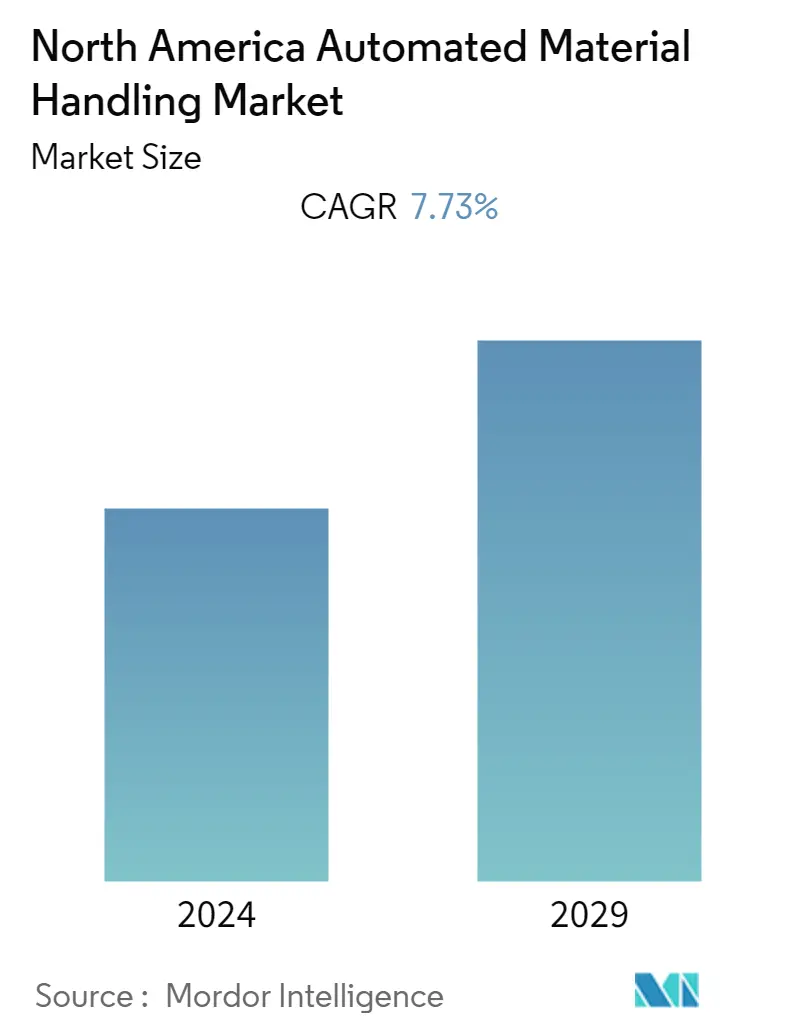
| Study Period | 2019 - 2029 |
| Base Year For Estimation | 2023 |
| Forecast Data Period | 2024 - 2029 |
| Historical Data Period | 2019 - 2022 |
| CAGR | 7.73 % |
| Market Concentration | Low |
Major Players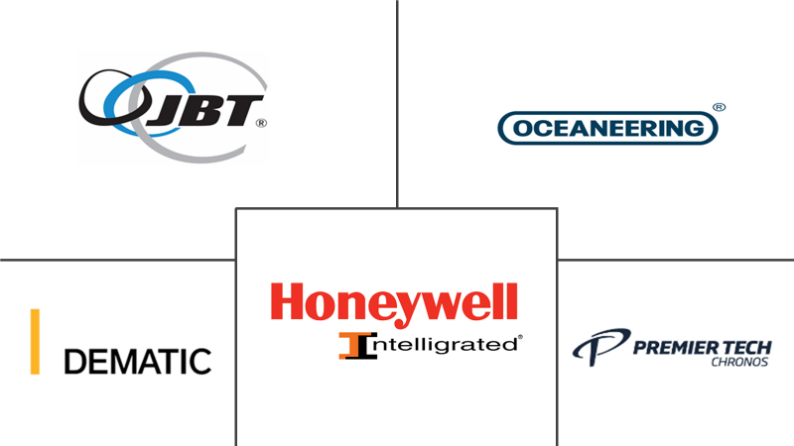
*Disclaimer: Major Players sorted in no particular order |
North America Automated Material Handling Market Analysis
The North America Automated Material Handling Market is expected to register a CAGR of 7.73% during the forecast period. Automated material handling is a concept derived from material handling practices, which uses several types of machinery to help workers in a manufacturing establishment move the product under construction between assembly stations or move completed goods to storage facilities.
- As more businesses turn to automation to boost efficiency in the warehouse, lower costs, and stay competitive in the market, they also make the workplace safer for employees in the process. One of the main motivations for automated material handling is improving working and safety conditions. According to the United States Bureau of Labor Statistics, in 2021, slips, stumbles, and falls were the cause of 27% of nonfatal occupational injuries that required days off from work. More than 235,000 people had to take time off work as a result of equipment or object contact. Automating material handling tasks allows manufacturers to remove workers from dangerous or repetitive work. This allows them to redeploy talent to other areas of the workplace where workers can be more productive, safe, and fulfilled.
- Sectors, including retail, automotive, food and beverage, and pharmaceutical, are the largest sources of demand for automated material handling solutions in the country. Food and beverage is the largest industry and represents more than 35% of US packaging shipments annually.
- Additionally, owing to low vacancy and a surge in the rental prices of warehouses, enterprises are progressively looking for smaller places to rent out for warehouse purposes. In order to optimize the productivity of these narrow spaces, they are expected to deploy more automated solutions soon.
- Moreover, the e-commerce logistics costs in the United States account for over 6.9% of the total US logistics costs. The importance of the last mile in the supply chain will never be lost; however, manufacturers realize that there is no last mile without the first. Applying the proper material handling technology produces measurable cost savings while bringing an immediate ROI.
- The COVID-19 pandemic had an impact on a variety of businesses, including small and big manufacturers. It limited the demand for products in the automated material handling system market on a global scale to some extent. The product development life cycle was significantly impacted by a small workforce and operational constraints. After the lockdown restrictions were later eased, demand stabilized to some extent. Companies created various technologies and methods to address issues caused by COVID-19. Further, in July 2020, a study released by Honeywell suggested that over 50% of U.S. companies have shown openness to investing in automation to survive changing market conditions. The 2020 Honeywell Integrated Automation Investment Study highlighted that the e-commerce (66%); grocery, food, and beverage (59%); and logistics (55%) industries are the forerunners in investing more in automation.
North America Automated Material Handling Market Trends
This section covers the major market trends shaping the North America Automated Material Handling Market according to our research experts:
Retail/Warehousing/Logistics to Hold Significant Share
- The United States boasts a robust E-commerce ecosystem. According to the US Census Bureau, from January to March 2022, US retail e-commerce sales accounted for almost USD 250 billion, marking a 2.4% increase compared to the previous quarter. The rapidly evolving retail market is encouraging distribution centers to find and use innovative, flexible, and automated approaches to e-commerce order fulfillment.
- E-commerce is a significant driving factor for the demand from automated distribution warehouses, as consumers seek ever-shorter delivery times. Also, changing consumer needs and innovation in delivery methods are expected to drive the US retailing market. With the e-commerce market expected to witness robust growth, the demand for AMH equipment from the US retail end-user segment is also expected to increase.
- With a retail backroom or distribution center that is easy to steer and is well-organized, automated material handling equipment help ensure overall customer satisfaction and makes stocking and inventory more efficient. For instance, companies like REB furnish, deliver, and install material handling and storage systems nationwide in the United States, focusing on meeting customer satisfaction.
- Retail is one of the major industries in which the requirement for conveyors and sortation is important. It helps online retailers to sort goods and enhance delivery efficiency. Furthermore, retail companies are also adopting this automated material handling equipment to perform last-mile delivery.
- With a retail backroom or distribution center that is easy to steer and is well-organized, automated material handling equipment help ensure overall customer satisfaction and makes stocking and inventory more efficient. For instance, companies like REB furnish, deliver, and install material handling and storage systems for the retail sector nationwide in the United States, focusing on meeting customer satisfaction.
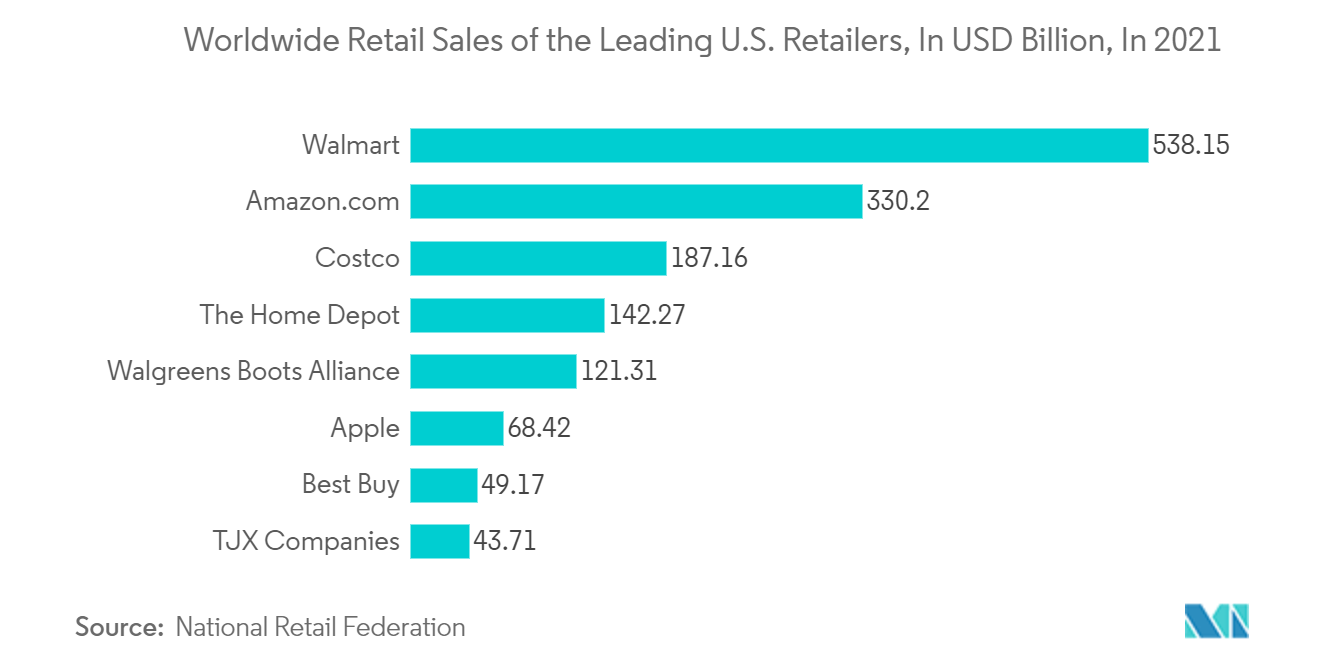
United States to Hold Major Share
- The United States is the most advanced economy in the world. The country's manufacturing sector, which is a huge source of demand for the AMH market, hinges on the dominant US economy, accounting for 82% of the region's economic output.
- The country has a high trading profile and a highly active e-commerce sector, which increases the demand for warehouse space. Moreover, the North American airport industry is one of the largest airport industries in the world. It provides services to about 1,011.5 million domestic and international passengers every year. It is also home to some of the world's biggest airports and is expected to bolster the adoption of automation to ensure no disruptions in the business model.
- The United States is home to one of the largest automotive markets in the world, with the presence of various global vehicle and auto part manufacturers. With the increasing demand for automotive vehicles and the United States being one of the largest exporters and manufacturers (second-largest), coupled with increasing investment, the market studied is expected to witness significant demand from the US automotive industry.
- Additionally, the US pharmaceutical industry is experiencing slow growth with the changing pharmaceutical landscape and diminished productivity in R&D. Digitalization and automation in the region, at every point along the value chain, help the pharmaceutical industry get pharmaceuticals from the lab to the patient more swiftly. New policy reforms are expected to influence market growth over the forecast period. Trends, such as patient-centric healthcare and biosimilars, is expected to positively impact the growth of the market studied.
- Furthermore, the increasing labor rates in the region are also developing the need for new technologies which help in reducing the dependency on laborers for material handling. According to Statistics Canada, Labour costs per unit of output of Canadian businesses rose 2.7% in the second quarter of 2021, following slight increases in the previous two quarters. This was the highest quarterly growth rate in a year.
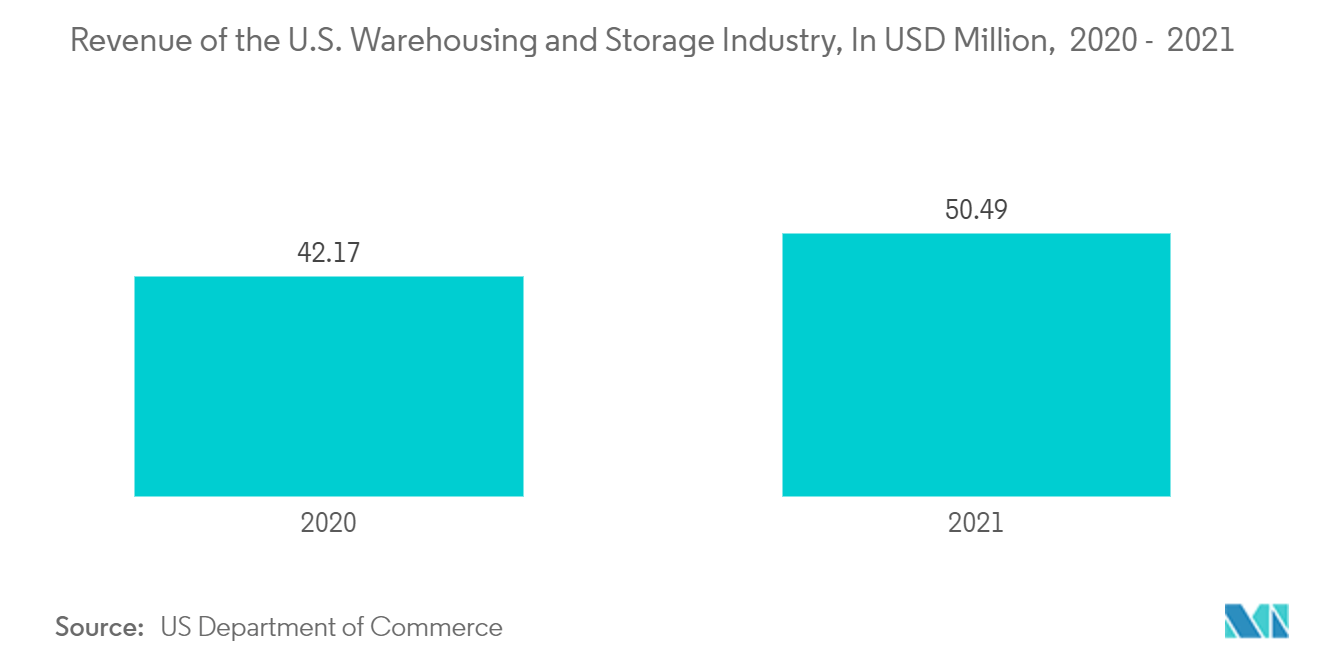
North America Automated Material Handling Industry Overview
The automated material handling market is moderately consolidated, with a range of hardware, software, and service providers. However, major vendors such as Daifuku Co. Ltd, Kardex Group, KION Group, JBT Corporation, and many more are highly preferred automated material handling product/solution/service providers across small and large enterprises. The firms are renewing their partnership with material handling companies due to the benefits of the market.
- July 2022 - JBT Corporation acquired Alco-food-machines GmbH & Co. KG (Alco), a provider of other food processing solutions and production lines. The deployment of advanced and automated material handling equipment helps the company ensure the safety of products and employees without compromising process quality, time, and profits. Alco represents the ideal fit for JBT, where the brands approach the broad food and beverage platform and offer a compelling succession opportunity for companies with leading technology and food domain expertise.
- November 2021 - Westfalia's automated storage/retrieval system (AS/RS) and Savanna.NET Warehouse Execution System (WES) will fully automate food manufacturing. Kens foods chose Westfalia Technologies to automate the new Atlanta-area warehouse. Westfalia's technology will provide a reliable, temperature-controlled warehousing environment with a customized solution addressing all material handling while delivering almost zero touches from receiving to shipping.
North America Automated Material Handling Market Leaders
-
John Bean Technologies Corporation
-
Oceaneering International Inc.
-
Dematic Corp.
-
Honeywell Intelligrated
-
Premier Tech Chronos
*Disclaimer: Major Players sorted in no particular order
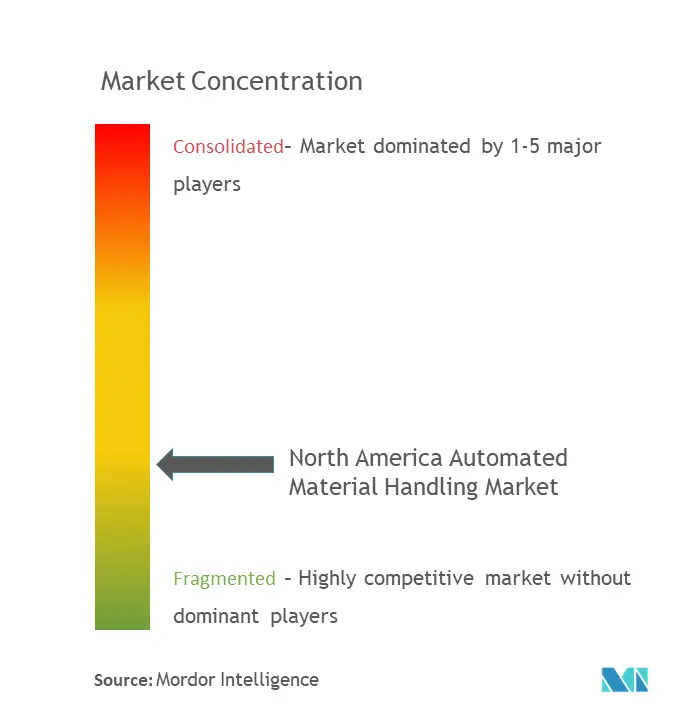
North America Automated Material Handling Market News
- August 2022 - Alstef has unveiled a mobile robot, the BAGXone, for handling baggage at airports. It is a high-speed automated guided vehicle designed to handle individual bags. It is capable of covering short distances, from check-in to screening machines as well as from screening machines to an early bag store, reconciliation room, etc.
- August 2022 - Vanderlande, a warehouse automation giant, has selected Kollmorgen NDC Solutions as a technology and service partner for their AGV applications. The company aims to grow and strengthen its portfolio of complete logistics and warehouse solutions.
- November 2021 - Shoppa's Material Handling and Dematic, two companies delivering sophisticated warehouse systems, announced the integration of Dematic equipment into Shoppa's solutions to expand capabilities for customers across North America. The partnership with Dematic reflects Shoppa's ongoing commitment to developing the solutions available to the clients.
- April 2021 - JBT exhibited the warehouse AGV, which can operate in an array of temperatures, from -10ºF to 110ºF, offering operations a lift capacity of 2,500 pounds. The automatic guided vehicle (AGV) features a triple-stage hydraulic mast with an integrated side shift and tilt. The company produced and fielded an AGV that can live in a freezer, service 10-foot 6-inch aisles, and reach storage locations up to 422 inches.
North America Automated Material Handling Market Report - Table of Contents
1. INTRODUCTION
- 1.1 Study Assumptions and Market Definition
- 1.2 Scope of the Study
2. RESEARCH METHODOLOGY
3. EXECUTIVE SUMMARY
4. MARKET INSIGHTS
- 4.1 Market Overview
-
4.2 Industry Attractiveness - Porter's Five Forces Analysis
- 4.2.1 Bargaining Power of Suppliers
- 4.2.2 Bargaining Power of Consumers
- 4.2.3 Threat of New Entrants
- 4.2.4 Threat of Substitutes
- 4.2.5 Intensity of Competitive Rivalry
- 4.3 Impact of COVID-19 on the Automated Material Handling Market
5. MARKET DYNAMICS
-
5.1 Market Drivers
- 5.1.1 Increasing Technological Advancments Aiding Market Growth
- 5.1.2 Industry 4.0 Investments Driving the Demand for Automation and Material Handling
- 5.1.3 Rapid Growth of E-Commerce
-
5.2 Market Challenges
- 5.2.1 High Initial Costs
- 5.2.2 Unavailability for Skilled Workforce
6. MARKET SEGMENTATION
-
6.1 By Product Type
- 6.1.1 Hardware
- 6.1.2 Software
- 6.1.3 Services
-
6.2 By Equipment Type
- 6.2.1 Mobile Robots
- 6.2.1.1 Automated Guided Vehicle (AGV)
- 6.2.1.1.1 Automated Forklift
- 6.2.1.1.2 Automated Tow/Tractor/Tug
- 6.2.1.1.3 Unit Load
- 6.2.1.1.4 Assembly Line
- 6.2.1.1.5 Special Purpose
- 6.2.1.2 Autonomous Mobile Robots (AMR)
- 6.2.1.3 Laser Guided Vehicle
- 6.2.2 Automated Storage and Retrieval System (ASRS)
- 6.2.2.1 Fixed Aisle (Stacker Crane + Shuttle System)
- 6.2.2.2 Carousel (Horizontal Carousel + Vertical Carousel)
- 6.2.2.3 Vertical Lift Module
- 6.2.3 Automated Conveyor
- 6.2.3.1 Belt
- 6.2.3.2 Roller
- 6.2.3.3 Pallet
- 6.2.3.4 Overhead
- 6.2.4 Palletizer
- 6.2.4.1 Conventional (High Level + Low Level)
- 6.2.4.2 Robotic
- 6.2.5 Sortation System
-
6.3 By End-user Vertical
- 6.3.1 Airport
- 6.3.2 Automotive
- 6.3.3 Food and Beverage
- 6.3.4 Retail/Warehousing/ Distribution Centers/Logistic Centers
- 6.3.5 General Manufacturing
- 6.3.6 Pharmaceuticals
- 6.3.7 Post and Parcel
- 6.3.8 Other End Users
-
6.4 By Country
- 6.4.1 United States
- 6.4.2 Canada
7. COMPETITIVE LANDSCAPE
-
7.1 Company Profiles
- 7.1.1 JBT Corporation
- 7.1.2 Oceaneering International Inc.
- 7.1.3 Dematic Corp.
- 7.1.4 Honeywell Intelligrated
- 7.1.5 Premier Tech Chronos
- 7.1.6 DMW&H
- 7.1.7 Westfalia Technologies Inc.
- 7.1.8 OPUS Automation Inc.
- 7.1.9 Creative Automation Inc.
- 7.1.10 Remtec Automation
- 7.1.11 Shuttleworth LLC
- 7.1.12 Siggins
- 7.1.13 Cornerstone Automation Systems LLC
- *List Not Exhaustive
8. INVESTMENT ANALYSIS
9. FUTURE OF THE MARKET
** Subject To AvailablityNorth America Automated Material Handling Industry Segmentation
The North America Automated Material Handling Market is segmented by Product Type (Hardware, Software, and Services), Mobile Robots (AGV (Automated Forklift, Automated Tow/Tractor/Tug, Unit Load, Assembly Line, Special Purpose), Autonomous Mobile Robots, Laser Guided Vehicles), Equipment Type (AS/RS (Fixed Aisle, Carousels, Vertical Lift Modules), Automated Conveyor (Belt, Roller, Pallet, Overhead), Palletizer (Conventional, Robotic), Sortation System), by End-user Vertical (Airport, Automotive, Food and Beverage, Retail/Warehousing/DC/Logistic Center, General Manufacturing, Pharmaceutical, Post and Parcel), and by Country.
| By Product Type | Hardware | ||
| Software | |||
| Services | |||
| By Equipment Type | Mobile Robots | Automated Guided Vehicle (AGV) | Automated Forklift |
| Automated Tow/Tractor/Tug | |||
| Unit Load | |||
| Assembly Line | |||
| Special Purpose | |||
| By Equipment Type | Mobile Robots | Autonomous Mobile Robots (AMR) | |
| Laser Guided Vehicle | |||
| By Equipment Type | Automated Storage and Retrieval System (ASRS) | Fixed Aisle (Stacker Crane + Shuttle System) | |
| Carousel (Horizontal Carousel + Vertical Carousel) | |||
| Vertical Lift Module | |||
| By Equipment Type | Automated Conveyor | Belt | |
| Roller | |||
| Pallet | |||
| Overhead | |||
| By Equipment Type | Palletizer | Conventional (High Level + Low Level) | |
| Robotic | |||
| By Equipment Type | Sortation System | ||
| By End-user Vertical | Airport | ||
| Automotive | |||
| Food and Beverage | |||
| Retail/Warehousing/ Distribution Centers/Logistic Centers | |||
| General Manufacturing | |||
| Pharmaceuticals | |||
| Post and Parcel | |||
| Other End Users | |||
| By Country | United States | ||
| Canada |
North America Automated Material Handling Market Research FAQs
What is the current North America Automated Material Handling Market size?
The North America Automated Material Handling Market is projected to register a CAGR of 7.73% during the forecast period (2024-2029)
Who are the key players in North America Automated Material Handling Market?
John Bean Technologies Corporation, Oceaneering International Inc., Dematic Corp., Honeywell Intelligrated and Premier Tech Chronos are the major companies operating in the North America Automated Material Handling Market.
What years does this North America Automated Material Handling Market cover?
The report covers the North America Automated Material Handling Market historical market size for years: 2019, 2020, 2021, 2022 and 2023. The report also forecasts the North America Automated Material Handling Market size for years: 2024, 2025, 2026, 2027, 2028 and 2029.
North America Automated Material Handling Industry Report
Statistics for the 2024 North America Automated Material Handling market share, size and revenue growth rate, created by Mordor Intelligence™ Industry Reports. North America Automated Material Handling analysis includes a market forecast outlook 2029 and historical overview. Get a sample of this industry analysis as a free report PDF download.



